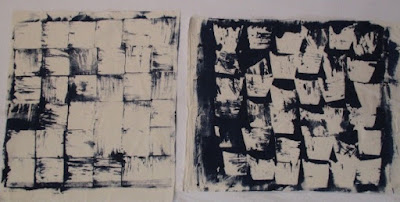While I continue to develop screens for printing designs on napkins, I thought I'd also try some folding techniques, while I also tried out a few more colors. In these seven napkins, each fabric square was dyed one color, low water immersion, and washed out. Then I soda-soaked again, folded in various patterns, and overdyed with a 3% solution of Dharma's MX Indigo dye. Depending on the base color, the dark blue Indigo overdye either stayed dark blue (over light blue and lavender) or changed as it merged with the base color (most noticeable on the rust colored fabric, where the orange and blue together turned the darker color to more of a brown). Here's a record of the folds, starting at the top and going left to right for each row:
- Light blue base: a diagonal accordion fold, with dark blue applied in horizontal bands.
- Gray base: diagonal accordion fold
- Pumpkin base: folded in half to make a triangle, then accordion folded perpendicular to base of triangle.
- Tan base: One corner secured with a clothespin, holding on to the opposite corner, I twisted the fabric like a rope.
- Green base: folded vertically, and then a flag fold.
- Rust base: folded vertically, then folded horizontally into small squares.
- Lavender base: This one not folded, but simply scrunced into a tight "hockey puck" in the base of a small plastic container and the dye poured on both sides.
My goal is to have designs that look appealing when the napkin is folded, as well as when it's open. Getting the design to look good on the folded napkin is the more challenging of the two. I think all of these work OK, with my favorites probably #1, 4, and 6. I like #3 better in the folded state than unfolded. Your opinion most welcome!







